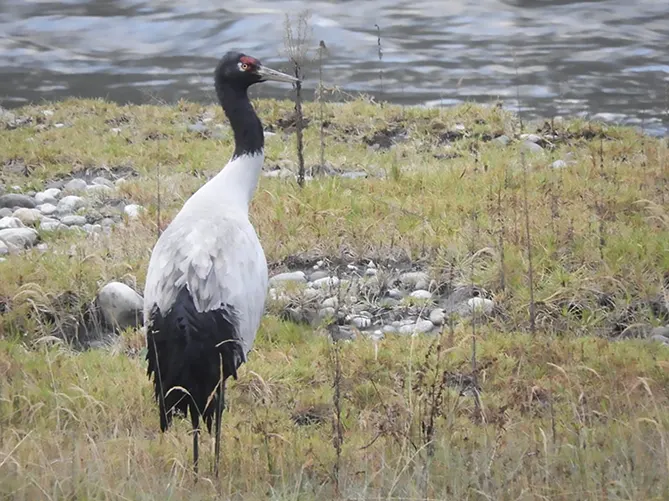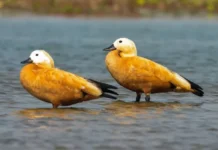[ Prem Chetry ]
ZEMITHANG, 17 Nov: The highly revered and endangered black-necked crane, which visits its wintering sites at Zemithang in Tawang and Sangti Valley in West Kameng, now faces an uncertain future due to growing human activities in these areas.
The arrival of two black-necked cranes at their wintering site along the Nyamjang Chhu River in Zemithang was reported on Friday. This short 3-km stretch of the river, between Brokenthang and Zemithang, is one of only two regular, long-term wintering sites for this revered bird in India.
However, according to local residents, the pair of cranes that arrived on Friday has since left, while another single crane landed at the site the following day.
Zemithang, known for its rich cultural and religious heritage, has also become recognized as a top tourist destination and vibrant village. The area is home to rich Himalayan biodiversity. Local environmental enthusiasts have expressed concern, saying, “We need development, but it should not come at the cost of our rich biodiversity, especially when it involves the black-necked cranes.”
They are particularly worried about protecting the cranes during their stay from mid-November to mid-March. “All activities related to mineral extraction or any other activities that disturb these birds should be immediately banned,” they said.
To ensure the safety of the cranes, Zemithang EAC Deewan Mara stated, “The Zemithang administration already has a standing order to shut down quarries and crusher units along the banks of the Nyamjang Chhu. Any violations will result in a penalty of Rs. 10,000, along with legal action as per the law.”
“We are also coordinating with WWF for the conservation of the cranes, and I am personally monitoring the situation. We believe our timely intervention has contributed to the cranes’ visit,” he added.
Pemba Tsering Romo, a field assistant for WWF India, confirmed the arrival of the cranes and is actively monitoring their stay and numbers. According to locals, a single crane usually arrives first, followed by a pair after 2-3 days, and then the pair brings a juvenile after another 3-4 days. The black-necked cranes are highly revered by the Monpas, who believe the birds are the embodiment of the Sixth Dalai Lama and view them as an auspicious sign.
In Sangti Valley, West Kameng district, residents reported that no cranes have arrived so far this year. However, they are concerned that increasing human habitation and activities near the cranes’ wintering site could discourage the birds from staying. If these activities continue, they fear that in the near future, the cranes may no longer visit the area.
Environmental enthusiasts from both Tawang and West Kameng districts are calling on the authorities to designate these wintering sites as protected areas, where no human activities should be allowed during the cranes’ stay.







